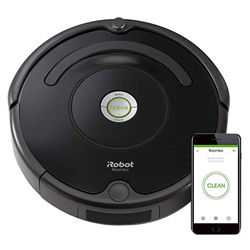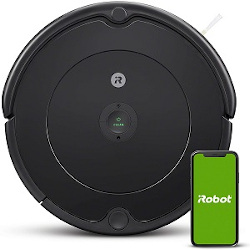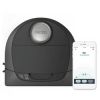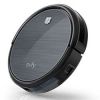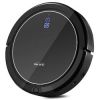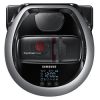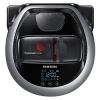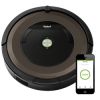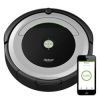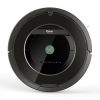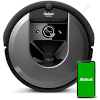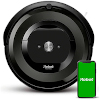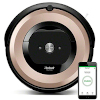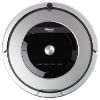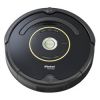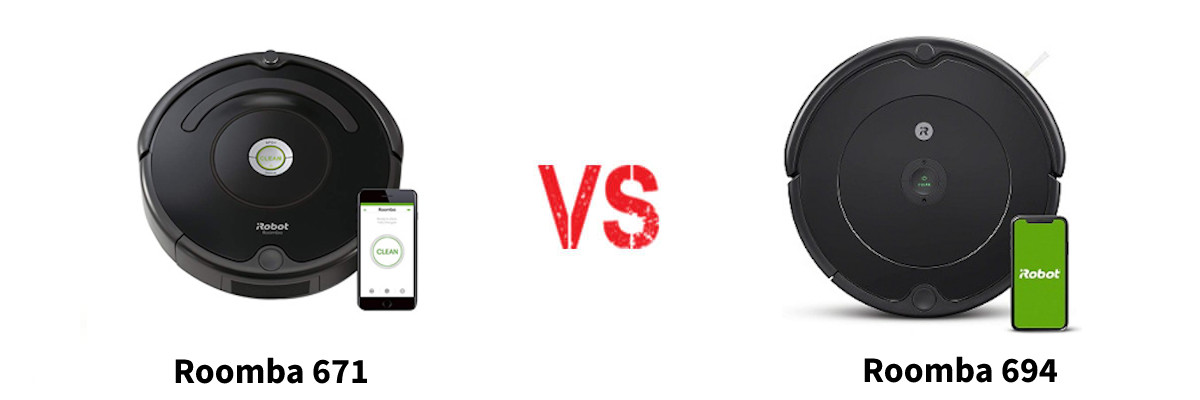
Roomba 671 vs 694: 120 vs 90 Minutes Battery Life
Admittedly, a comparison of the Roomba 671 vs 694 vacuum cleaners shows that both robots are mid-range robotic cleaners with similar features and performance. However, the 694 performs better on bare floors and high-pile carpets than the 671. Also, the 671 robot boasts a carrying handle, making it easier to pick up the iRobot cleaner and carry it, a feature lacking in the 694. Both robots come with AeroVac filters, while the 671 robot is slightly pricier than the 694 robot.
Suction and dustbin capacity
After closely comparing the suction force of the Roomba 671 vs 694, I found that the 694 model has a little more efficient motor. Yet, both robot vacuum cleaners' 600 Pa suction forces are similar. Both robot cleaners are decent vacuum cleaners on bare floors; however, they are well-built and compact, fitting comfortably under most furniture. When you compare the dustbin capacities of the 671 and 694 robotic vacuum cleaners, you'll see that the 671 model has a 0.35 liter dustbin while the 694 model has a 0.6 liter dustbin. The 694 robot dustbin can thus hold more dirt and waste before requiring your emptying.
Using area
The Roomba 671 vs 694 has a powerful motor suitable for small and medium-sized homes with an average cleaning area of 1500 square feet. The 1800mAh battery in the 671 robot allows it to clean for 120 minutes, covering an area of 1500 square feet. In contrast, the 2600mAh battery in the 694 allows the robot to clean for 90 minutes and covers an area of 1000 square feet.
The robotic vacuum cleaners Roomba 671 and 694 use iAdapt navigation technology to avoid obstacles and clean underneath furniture. Both have sensors, and in areas with greater dirt, the dirt detection technology adjusts the cleaning patterns and suction force to match the floor type. The 694 does not have a feature that allows you to shut off places you do not want the robot to clean, like the 671's virtual wall barriers.
Noise level
A review of the Roomba 671 vs 694 robotic vacuum reveals that both vacuum cleaners have similar noise levels of around 68 decibels — the same noise level as a normal conversation. Besides, while the noise level of these iRobot cleaners may not be completely silent, these robots are relatively quiet, which makes them a good choice if you don’t want to disturb your kids or your pets. The noise level of these robots varies depending on the floor type and the amount of dirt.
Carpet cleaning
Furthermore, comparing the 671 versus the 694, we see that the Roomba 694 has a larger edge-sweeping brush than the 671. This brush allows the 694 to easily agitate and sweep debris and dirt from the edges of carpets. Carpets, tiles, and hardwood floors can be cleaned by both robot cleaners, and they sport a 3-stage cleaning system that brushes, lifts, and suctions dust, dirt, debris, and hair from carpets, tiles, etc, and hard floors. Both vacuum cleaners are efficient in cleaning carpets due to their multi-surface brushes, edge-sweeping brushes, and their powerful vacuum motor. The 671 and 694 robots feature AeroVac filters that capture debris, dirt, and pollen that may result in allergies.
Roomba 671 pros & cons
- The robot has a recharge and resume feature to complete large cleaning jobs.
- It supports voice command and is compatible with Amazon Alexa and Google Assistant.
- The vacuum cleaner comes with cliff sensors that prevent it from falling down stairs.
- It fails to find its charging dock sometimes.
- The robot does not have advanced mapping technology.
- The robot does not deal well with contrasting multiple colors in rugs or carpets as it sees them as cliffs and stops cleaning.
Roomba 694 pros & cons
- The robot is budget-friendly.
- It supports a recharge and resume feature.
- The robot offers a time-scheduling function.
- No mapping technology.
- Limited battery life for an extensive cleaning area.
- The robot struggles with fine debris.

